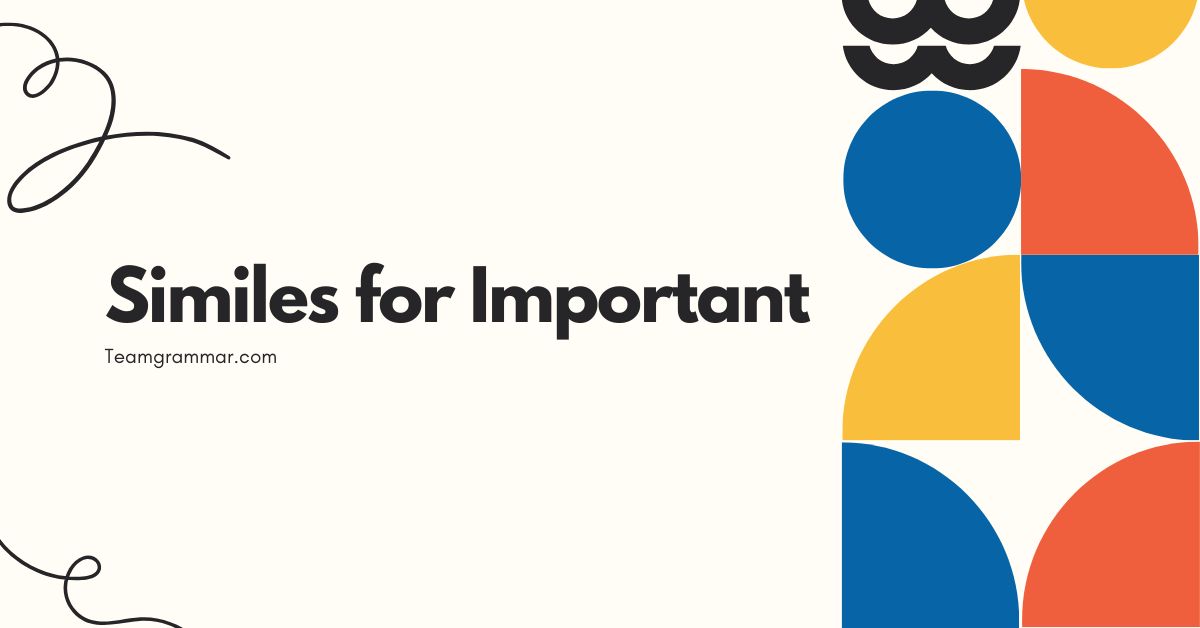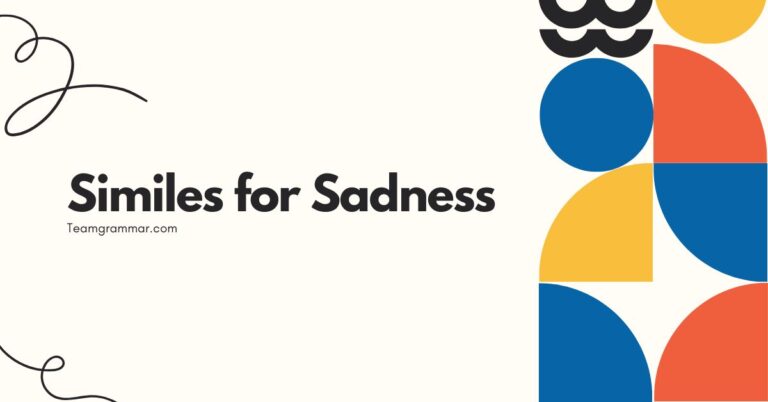49 Similes for Important: Mastering Figurative Language
Understanding similes is crucial for enhancing your writing and communication skills. Similes, a type of figurative language, allow you to draw vivid comparisons, making your descriptions more engaging and memorable.
This article focuses specifically on similes that convey the concept of “important,” providing you with a range of examples and guidance on their effective use. Whether you’re a student, a writer, or simply someone looking to improve your English, this comprehensive guide will equip you with the knowledge and tools to master similes for “important.”
By exploring different types of similes, understanding their structural components, and practicing their application, you’ll gain a deeper appreciation for the nuances of the English language. This article will also address common mistakes and provide practical exercises to reinforce your learning.
Get ready to enrich your vocabulary and elevate your writing with the power of similes!
Table of Contents
- Definition of Simile
- Structural Breakdown of Similes
- Types of Similes for “Important”
- Examples of Similes for “Important”
- Usage Rules for Similes
- Common Mistakes with Similes
- Practice Exercises
- Advanced Topics in Similes
- Frequently Asked Questions
- Conclusion
Definition of Simile
A simile is a figure of speech that compares two different things using the words “like” or “as.” Its primary function is to create a vivid image or convey a particular quality by associating it with something familiar or easily understood. Similes are a fundamental tool in descriptive writing and persuasive communication, adding depth and color to language.
Unlike metaphors, which directly equate two things (e.g., “He is a lion”), similes acknowledge the difference between the two things being compared, highlighting their shared characteristics. This indirect comparison can make the description more nuanced and relatable.
Similes are not limited to literary contexts; they are commonly used in everyday conversation to explain complex ideas, express emotions, or simply add emphasis. Understanding and using similes effectively can significantly enhance your ability to communicate clearly and creatively.
Classification of Similes
Similes can be classified based on the type of comparison they make. Some similes focus on physical attributes, while others emphasize emotional or abstract qualities.
The classification depends on the specific elements being compared and the intended effect of the comparison.
Function of Similes
The primary function of a simile is to enhance understanding and create a vivid mental image. By comparing something unfamiliar to something familiar, similes make complex ideas more accessible.
They also add emotional depth and persuasive power to writing and speech.
Contexts for Using Similes
Similes are appropriate in a wide range of contexts, from formal writing to casual conversation. They are particularly useful in descriptive passages, persuasive arguments, and creative storytelling.
However, it’s important to choose similes that are relevant and meaningful to the audience.
Structural Breakdown of Similes
A simile typically consists of three main components: the subject being described, the linking word (“like” or “as”), and the object of comparison. Understanding these components is essential for constructing effective and meaningful similes.
The subject is the thing you want to describe or emphasize. The linking word establishes the comparison between the subject and the object.
The object of comparison is the thing that shares a relevant characteristic with the subject, providing a point of reference for the reader or listener.
The order of these components can sometimes be varied for stylistic effect, but the core structure remains the same: subject + linking word + object of comparison.
The Subject
The subject is the entity whose importance you are trying to convey. It could be an idea, a person, a task, or any other noun or noun phrase.
The Linking Word
The linking word, either “like” or “as,” is crucial for signaling that a comparison is being made. While both words serve the same basic function, “as” can sometimes imply a stronger or more direct similarity than “like.”
The Object of Comparison
The object of comparison is the key to a successful simile. It should be something that is widely understood and that clearly illustrates the importance of the subject.
The more vivid and relevant the object of comparison, the more effective the simile will be.
Types of Similes for “Important”
When crafting similes to express the importance of something, you can draw upon various categories of comparisons. These categories include comparisons to things that are essential, valuable, powerful, or central.
Here are some common types:
Similes Emphasizing Essential Nature
These similes compare the subject to something that is absolutely necessary or vital for survival. They highlight the indispensable nature of the subject.
Similes Emphasizing Value
These similes compare the subject to something that is highly prized or cherished, emphasizing its worth and significance.
Similes Emphasizing Power and Influence
These similes compare the subject to something that wields great power or influence, highlighting its impact and importance.
Similes Emphasizing Centrality and Focus
These similes compare the subject to something that is at the center of attention or activity, emphasizing its focal point and importance.
Examples of Similes for “Important”
Here are several examples of similes that convey the concept of “important,” categorized by the type of comparison they make. Each category includes a variety of examples to illustrate the range and versatility of similes.
Similes Emphasizing Essential Nature
The following table provides examples of similes that highlight the essential nature of something, comparing it to elements vital for survival or fundamental to a process.
| Simile | Explanation |
|---|---|
| As important as water to a desert traveler. | Highlights the life-saving necessity. |
| As important as air to a diver. | Emphasizes the crucial requirement for survival. |
| As important as the sun to plant life. | Illustrates the fundamental role in growth and sustenance. |
| As important as sleep to a weary soul. | Highlights the restorative and essential nature. |
| As important as a foundation to a skyscraper. | Emphasizes the fundamental support and stability. |
| As important as roots to a tree. | Highlights the source of sustenance and stability. |
| As important as oxygen to breathing. | Emphasizes an absolute, life-sustaining necessity. |
| As important as food to a starving person. | Highlights the critical need for nourishment. |
| As important as medicine to a sick patient. | Emphasizes the healing and recovery aspect. |
| As important as education to a child’s future. | Illustrates the fundamental role in development and opportunity. |
| As important as a compass to a lost explorer. | Emphasizes the guidance and direction provided. |
| As important as a map to a traveler. | Highlights the guidance needed to navigate. |
| As important as a key to a locked door. | Emphasizes the access and opportunity provided. |
| As important as fuel to a rocket. | Illustrates the necessary power for propulsion. |
| As important as a heartbeat to life. | Highlights the essential rhythm of existence. |
| As important as the engine to a car. | Emphasizes the core functionality. |
| As important as the heart to the body. | Highlights the vital organ’s role. |
| As important as the brain to thinking. | Emphasizes the central role in cognitive function. |
| As important as the password to an account. | Illustrates the necessity for access and security. |
| As important as rest to recovery. | Highlights the essential element for healing. |
| As important as practice to mastery. | Emphasizes the necessity for skill development. |
| As important as seeds to a harvest. | Highlights the fundamental element for growth. |
| As important as a lawyer to a defendant. | Emphasizes the vital role in legal defense. |
| As important as a doctor to a patient. | Highlights the vital role in health care. |
Similes Emphasizing Value
The following table provides examples of similes that highlight the value of something, comparing it to precious items, cherished relationships, or significant achievements.
| Simile | Explanation |
|---|---|
| As important as gold to a treasure hunter. | Highlights the immense value and desirability. |
| As important as a family heirloom. | Emphasizes the sentimental and historical value. |
| As important as a winning lottery ticket. | Illustrates the life-changing value and opportunity. |
| As important as a close friendship. | Highlights the emotional support and companionship. |
| As important as a mother’s love. | Emphasizes the unconditional and nurturing value. |
| As important as a rare diamond. | Highlights the exceptional value and rarity. |
| As important as a work of art. | Emphasizes the cultural and aesthetic value. |
| As important as a historical artifact. | Highlights the historical and educational value. |
| As important as freedom to a prisoner. | Emphasizes the liberation and opportunity value. |
| As important as peace to a war-torn country. | Illustrates the restorative and harmonious value. |
| As important as water in a drought. | Highlights the extreme value during scarcity. |
| As important as a lifeline to a drowning person. | Emphasizes the critical value in a dire situation. |
| As important as a second chance. | Highlights the value of redemption and new beginnings. |
| As important as a mentor’s guidance. | Emphasizes the value of direction and support. |
| As important as clean water in a polluted area. | Highlights the benefit of purity in a contaminated environment. |
| As important as good health. | Emphasizes the importance of physical well-being. |
| As important as trust in a relationship. | Highlights the necessity of reliability and honesty. |
| As important as knowledge to progress. | Emphasizes the essential role of learning. |
| As important as innovation to development. | Illustrates the necessity for advancement. |
| As important as creativity to art. | Highlights the essential element of artistic expression. |
| As important as teamwork to success. | Emphasizes the necessity of collaboration. |
| As important as ethics in business. | Highlights the necessity of morality in commerce. |
| As important as kindness to humanity. | Emphasizes the essential role of compassion. |
| As important as hope to the hopeless. | Highlights the vital role in difficult times. |
Similes Emphasizing Power and Influence
The following table provides examples of similes that highlight the power and influence of something, comparing it to forces of nature, influential figures, or dominant entities.
| Simile | Explanation |
|---|---|
| As important as a king’s decree. | Highlights the authoritative power and influence. |
| As important as a CEO’s decision. | Emphasizes the impact on a company’s direction. |
| As important as a general’s command in battle. | Illustrates the strategic importance and control. |
| As important as a judge’s ruling in court. | Highlights the legal authority and consequence. |
| As important as a parent’s guidance. | Emphasizes the formative influence and direction. |
| As important as a doctor’s diagnosis. | Highlights the impact on health and treatment. |
| As important as a teacher’s lesson. | Emphasizes the impact on learning and knowledge. |
| As important as a politician’s promise. | Highlights the potential impact on society. |
| As important as a scientist’s discovery. | Emphasizes the potential to change how we understand the world. |
| As important as a writer’s words. | Highlights the power to influence thoughts and ideas. |
| As important as a strong current in a river. | Highlights the overwhelming force. |
| As important as gravity to the earth. | Emphasizes the fundamental force that holds things together. |
| As important as a key vote in a crucial election. | Highlights the weight of a single decision. |
| As important as a turning point in history. | Emphasizes the significance of a pivotal moment. |
| As important as a company’s reputation. | Highlights the value of positive standing. |
| As important as a brand’s identity. | Emphasizes the value of recognition and perception. |
| As important as a leader’s vision. | Highlights the importance of foresight and direction. |
| As important as a team’s strategy. | Emphasizes the necessity for planning. |
| As important as a company’s mission statement. | Highlights the guiding principles and purpose. |
| As important as a country’s constitution. | Emphasizes the fundamental laws and rights. |
| As important as a moral compass. | Highlights the guiding principles and values. |
| As important as a set of rules. | Emphasizes the necessity of order and structure. |
| As important as a code of ethics. | Highlights the guiding principles for conduct. |
Similes Emphasizing Centrality and Focus
The following table provides examples of similes that emphasize the centrality and focus of something, comparing it to the core of an object, the heart of a city, or the focal point of an event.
| Simile | Explanation |
|---|---|
| As important as the nucleus of a cell. | Highlights the central control and function. |
| As important as the heart of a city. | Emphasizes the vital center of activity and life. |
| As important as the sun in the solar system. | Illustrates the central position and influence. |
| As important as the main character in a story. | Highlights the central role in the narrative. |
| As important as the lead singer in a band. | Emphasizes the focal point of attention and performance. |
| As important as the central theme of a book. | Highlights the underlying message and purpose. |
| As important as the main ingredient in a recipe. | Emphasizes the essential component for the outcome. |
| As important as the key player on a team. | Highlights the central role in achieving success. |
| As important as the anchor of a news broadcast. | Emphasizes the central role in delivering information. |
| As important as the center of gravity. | Illustrates the point of balance and stability. |
| As important as the core values of a company. | Emphasizes the fundamental principles guiding behavior. |
| As important as the central processing unit (CPU) of a computer. | Highlights the key component for function. |
| As important as the keystone in an arch. | Emphasizes the central role in stability and support. |
| As important as the axis of a globe. | Highlights the central point around which everything revolves. |
| As important as the main event at a festival. | Emphasizes the focal point of the celebration. |
| As important as the climax of a movie. | Highlights the peak of the story and emotions. |
| As important as the main argument in a debate. | Emphasizes the central point of contention. |
| As important as the focus of a lens. | Highlights the point of clarity and perception. |
| As important as the pivot in a strategy. | Highlights the central point for adapting. |
| As important as the hub of a wheel. | Emphasizes the central point of connection and rotation. |
Usage Rules for Similes
While similes offer a creative way to enhance your writing, it’s important to use them correctly to avoid clichés or confusing comparisons. Here are some key rules to follow:
- Choose relevant comparisons: Ensure that the object of comparison shares a meaningful characteristic with the subject. Avoid comparisons that are too abstract or far-fetched.
- Avoid clichés: Steer clear of overused similes that have lost their impact. Instead, strive for originality and creativity.
- Be clear and concise: The simile should be easy to understand and should add clarity to the description, not confusion.
- Maintain consistency: Ensure that the simile aligns with the overall tone and style of your writing.
Relevance in Similes
The most effective similes are those where the comparison is both clear and relevant. If the connection between the subject and the object is weak or unclear, the simile will fail to achieve its intended effect.
Avoiding Clichés in Similes
Clichéd similes are overused and lack originality. Using them can make your writing sound uninspired and predictable.
Instead of relying on clichés, try to come up with fresh and creative comparisons that will capture the reader’s attention.
Clarity in Similes
A good simile should enhance clarity, not create confusion. Ensure that the comparison is easy to understand and that it adds to the reader’s understanding of the subject.
Consistency in Similes
The simile should be consistent with the overall tone and style of your writing. Avoid using similes that are too informal or humorous in a serious or formal context.
Common Mistakes with Similes
Even experienced writers can make mistakes when using similes. Here are some common errors to watch out for:
- Using metaphors instead of similes: Confusing similes with metaphors can lead to inaccurate comparisons. Remember that similes use “like” or “as,” while metaphors directly equate two things.
- Creating illogical comparisons: Comparisons that don’t make sense or are based on faulty logic can confuse the reader.
- Overusing similes: Using too many similes in a short space can make your writing feel cluttered and distracting.
Here’s a table illustrating some common mistakes with similes, providing both incorrect and corrected examples:
| Incorrect | Correct | Explanation |
|---|---|---|
| He is as a lion. | He is like a lion. | Using “as” without a proper comparison. |
| The task was important as a car. | The task was as important as having a car in the city. | Illogical comparison. |
| The task was important like a rock. | The task was as important as the foundation of a building. | Not evocative enough. |
Practice Exercises
Test your understanding of similes with these practice exercises. For each question, choose the best simile to complete the sentence or identify the error in the simile.
Exercise 1: Completing Similes
Complete the following sentences with an appropriate simile to emphasize the importance of the subject.
| Question | Answer |
|---|---|
| 1. Education is ____________________ to a child’s future. | as important as a compass |
| 2. A good reputation is ____________________ to a business. | as important as a keystone |
| 3. Trust is ____________________ to a relationship. | as important as oxygen to breathing. |
| 4. A doctor’s diagnosis is ____________________ to a patient’s recovery. | as important as a lifeline |
| 5. Clean water is ____________________ in a drought. | as important as oxygen. |
| 6. Honesty is ____________________ to a friendship. | as important as a strong foundation. |
| 7. A mother’s love is ____________________ to a child. | as important as the sun to plant life. |
| 8. Freedom is ____________________ to a prisoner. | as important as water to a desert traveler. |
| 9. Peace is ____________________ to a war-torn country. | as important as sleep to a weary soul. |
| 10. Hope is ____________________ to someone in despair. | as important as medicine to a sick patient. |
Exercise 2: Identifying Errors in Similes
Identify the error in each of the following similes. Explain why the comparison is illogical or ineffective.
| Question | Answer |
|---|---|
| 1. The decision was as important like a tree. | Error: “like” used incorrectly with “as.” Corrected: The decision was as important as a tree’s roots. |
| 2. The event was important as a house. | Error: Illogical comparison. Corrected: The event was as important as the foundation of a house. |
| 3. The book was important as a shoe. | Error: Irrelevant comparison. Corrected: The book was as important as a guide in a new land. |
| 4. The meeting was important than gold. | Error: Incorrect comparative form. Corrected: The meeting was as important as finding gold. |
| 5. The task was important as a cloud. | Error: Abstract comparison. Corrected: The task was as important as clearing the clouds on a stormy day. |
| 6. The law is important as a cat. | Error: Irrelevant comparison. Corrected: The law is as important as the rules of the game. |
| 7. The idea was important as a spoon. | Error: Irrelevant comparison. Corrected: The idea was as important as a breakthrough invention. |
| 8. The lesson was important as a flower. | Error: Abstract comparison. Corrected: The lesson was as important as planting the seeds of knowledge. |
| 9. The rule was important as a door. | Error: Abstract comparison. Corrected: The rule was as important as the boundaries of the field. |
| 10. The plan was important as a stone. | Error: Abstract comparison. Corrected: The plan was as important as the blueprint of a house. |
Advanced Topics in Similes
For advanced learners, exploring the nuances of similes can involve examining their cultural context, historical usage, and variations in different genres of writing. Additionally, understanding how similes interact with other figures of speech, such as metaphors and analogies, can deepen your understanding of figurative language.
Cultural Context of Similes
The effectiveness of a simile often depends on the cultural context in which it is used. A comparison that is meaningful in one culture may not resonate in another.
Therefore, it’s important to be aware of the cultural implications of your similes.
Historical Usage of Similes
The use of similes has evolved over time, with different periods favoring different types of comparisons. Studying the historical usage of similes can provide insights into the changing values and beliefs of different societies.
Similes, Metaphors, and Analogies
While similes, metaphors, and analogies all involve making comparisons, they differ in their directness and scope. Similes use “like” or “as” to make explicit comparisons, while metaphors imply a comparison by stating that one thing is another.
Analogies, on the other hand, are more extended and complex comparisons that explain the relationship between two things.
Frequently Asked Questions
- What is the difference between a simile and a metaphor?
A simile uses “like” or “as” to compare two unlike things, explicitly stating the comparison (e.g., “He is as brave as a lion”). A metaphor, on the other hand, directly equates two things without using “like” or “as” (e.g., “He is a lion”).
- How can I avoid using clichés in my similes?
To avoid clichés, try to think of original and unexpected comparisons. Instead of relying on overused phrases, look for unique similarities between the subject and the object of comparison. Brainstorming and experimenting with different ideas can help you come up with fresh and creative similes.
- Can a simile be too complex?
Yes, a simile can be too complex if the comparison is difficult to understand or if it requires too much background knowledge. A good simile should be clear and concise, making the description more accessible to the reader.
- Is it okay to use similes in formal writing?
Yes, similes can be used in formal writing, but it’s important to use them judiciously and to ensure that they are appropriate for the tone and style of the writing. Avoid using overly informal or humorous similes in formal contexts.
- How do I choose the best simile for a particular situation?
To choose the best simile, consider the specific quality you want to emphasize and look for an object of comparison that clearly illustrates that quality. The best simile will be relevant, clear, and consistent with the overall tone of your writing.
- What if I can’t think of a good simile?
If you’re struggling to come up with a good simile, try brainstorming a list of possible comparisons. Think about the characteristics of the subject you want to describe and look for things that share those characteristics. You can also consult a thesaurus or dictionary for inspiration.
- Are there any types of writing where similes should be avoided?
While similes can enhance many types of writing, they may not be appropriate in highly technical or scientific contexts where precise and literal language is required. In these cases, it’s best to avoid figurative language altogether.
- How can I practice using similes effectively?
The best way to practice using similes effectively is to write regularly and to experiment with different comparisons. Pay attention to how other writers use similes and try to incorporate them into your own writing. You can also ask for feedback from others to help you improve your skills.
- Can similes be used in spoken language as well as written language?
Yes, similes are commonly used in both spoken and written language. They can add vividness and clarity to your speech, making your communication more engaging and memorable.
- How important is the choice of “like” versus “as” in a simile?
The choice between “like” and “as” is often a matter of stylistic preference. “As” can sometimes imply a stronger or more direct similarity, but in most cases, either word can be used effectively. The most important thing is to ensure that the simile is clear and meaningful.
Conclusion
Mastering similes is an invaluable skill for anyone looking to enhance their communication. By understanding the structure, types, and usage rules of similes, you can add depth, color, and clarity to your writing and speech.
Remember to choose relevant comparisons, avoid clichés, and strive for originality. The ability to craft effective similes can transform ordinary descriptions into memorable and impactful statements.
Continue to practice and experiment with similes in your writing and conversation. Pay attention to how other writers and speakers use similes and learn from their techniques.
With time and effort, you’ll develop a keen eye for creating compelling comparisons that will captivate your audience and elevate your communication skills. Keep exploring the power of figurative language and unlock your full potential as a writer and communicator!







